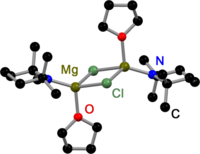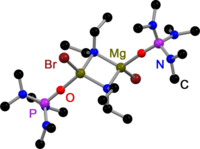Hauser base
Hauser bases, also called magnesium amide bases, are magnesium compounds used in organic chemistry as bases for metalation reactions. These compounds were first described by Charles R. Hauser in 1947.[1] Compared with organolithium reagents, the magnesium compounds have more covalent, and therefore less reactive, metal-ligand bonds. Consequently, they display a higher degree of functional group tolerance and a much greater chemoselectivity.[2] Generally, Hauser bases are used at room temperature while reactions with organolithium reagents are performed at low temperatures, commonly at −78 °C.
Structure
Hauser bases with the empirical formula R2NMgX feature halide (X-) bridges in the solid state for bulky amido (R2N) ligands such as 2,2,6,6-tetramethylpiperidine (TMP-) and HMDS-).[3][4][5]
Amido-bridged Hauser bases exist when the amido ligand is less bulky, such as Et2N- and Ph3P=N-.[4][6][7]
 |
 |
 |
The structures of Hauser bases in solution have been investigated by diffusion-ordered NMR spectroscopy (DOSY).[8] These studies indicate that iPr2NMgCl is subject to the Schlenk equilibrium:[9]
- iPr2NMgCl (A) ⇌ (iPr2N)2Mg (B) + MgCl2
This equilibrium is temperature-dependent: heteroleptic (A) are the main species at high temperatures and homoleptic (B) dominate at lower temperatures. Dimeric species with bridging chlorides and amides are also present in the THF solution. At low temperatures, adducts of MgCl2 are present in solution.[9]
Preparation and reactions
The Hauser bases are prepared by treating a secondary amine with a Grignard reagent:
- R2NH + R′MgX → R2NMgX + R′H X = Cl, Br, I
(:R2NH = diisopropylamine, TMP)
Like many organolithium reagents, Hauser bases are generally used for metalation reagents. iPr2NMgBr selectively magnesiate carboxamides.[10] iPr2NMgX (X = Cl, Br) effect the deprotonation thiophenes.[11] and phenylsulphonyl-substituted indoles.[12]


Turbo-Hauser base
A major disadvantage of Hauser bases is their poor solubility in THF. In consequence, the metalation rates are slow and a large excess of base is required (e.g., 10 equiv.). This circumstance complicates the functionalization of the metaled intermediate with an electrophile. Improved solubility and reactivity can be achieved by adding stoichiometric amounts of LiCl to the Hauser base. These so-called Turbo-Hauser bases like e.g. TMPMgCl·LiCl and iPr2NMgCl·LiCl are commercially available. They show an enhanced kinetic basicity, regioselectivity and functional group tolerance.[13]
References
- ^ Hauser C. R., Walker H (1947). "Condensation of Certain Esters by Means of Diethylaminomagnesium Bromide". J. Am. Chem. Soc. 69 (2): 295. doi:10.1021/ja01194a040.
- ^ Li–Yuan Bao, R.; Zhao, R.; Shi, L. (2015). "Progress and developments in the turbo Grignard reagent i-PrMgCl·LiCl: a ten-year journey". Chem. Commun. 51 (32): 6884–6900. doi:10.1039/C4CC10194D. PMID 25714498.
- ^ e.g.; Seven, Ö.; Bolte, M.; Lerner, H.-W. (2013). "Di-μ-bromido-bis[(diethyl ether-κO)(2,4,6-trimethylphenyl)magnesium]: the mesityl Grignard reagent" (PDF). Acta Crystallogr. E. 69 (7): m424. doi:10.1107/S1600536813017108. PMC 3772445. PMID 24046588.
- ^ a b García–Álvarez, P.; Graham, D. V.; Hevia, E.; Kennedy, A. R.; Klett, J.; Mulvey, R. E.; O'Hara, C. T.; Weatherstone, S. (2008). "Unmasking Representative Structures of TMP-Active Hauser and Turbo-Hauser Bases". Angew. Chem. Int. Ed. 47 (42): 8079–8081. doi:10.1002/anie.200802618. PMID 18677732.
- ^ Yang, K.-C.; Chang, C.-C.; Huang, J.-Y.; Lin, C.-C.; Lee, G.-H.; Wang, Y.; Chiang, M. Y. (2002). "Synthesis, characterization and crystal structures of alkyl-, alkynyl-, alkoxo- and halo-magnesium amides" (PDF). J. Organomet. Chem. 648 (1–2): 176–187. doi:10.1016/S0022-328X(01)01468-1.
- ^ Batsanov, A. S.; Bolton, P. D.; Copley, R. C. B.; Davidson, M. G.; Howard, J. A. K.; Lustig, C.; Price, R. D. (1998). "The metallation of imino(triphenyl)phosphorane by ethylmagnesium chloride: The synthesis, isolation and X-ray structure of [Ph3P=NMgCl·O=P(NMe2)3]2". J. Organomet. Chem. 550 (1–2): 445–448. doi:10.1016/S0022-328X(97)00550-0.
- ^ Armstrong D. R.; García–Álvarez, P.; Kennedy, A. R.; Mulvey, R. E.; Parkinson, J. A. (2010). "Diisopropylamide and TMP Turbo-Grignard Reagents: A Structural Rationale for their Contrasting Reactivities". Angew. Chem. Int. Ed. 49 (18): 3185–3188. doi:10.1002/anie.201000539. PMID 20352641.
- ^ Neufeld, R.; Stalke, D. (2015). "Accurate Molecular Weight Determination of Small Molecules via DOSY-NMR by Using External Calibration Curves with Normalized Diffusion Coefficients". Chem. Sci. 6 (6): 3354–3364. doi:10.1039/C5SC00670H. PMC 5656982. PMID 29142693.

- ^ a b Neufeld, R.; Teuteberg, T. L.; Herbst-Irmer, R.; Mata, R. A.; Stalke, D. (2016). "Solution Structures of Hauser Base iPr2NMgCl and Turbo-Hauser Base iPr2NMgCl·LiCl in THF and the Influence of LiCl on the Schlenk-Equilibrium". J. Am. Chem. Soc. 138 (14): 4796–4806. doi:10.1021/jacs.6b00345. PMID 27011251.
- ^ Eaton, P. E.; Lee, C. H.; Xiong, Y. (1989). "Magnesium amide bases and amido-Grignards. 1. Ortho magnesiation". J. Am. Chem. Soc. 138 (20): 8016–8018. doi:10.1021/ja00202a054.
- ^ Shilai, M.; Kondo, Y.; Sakamoto, T. (2001). "Selective metallation of thiophene and thiazole rings with magnesium amide base". J. Chem. Soc. Perkin Trans. 1 (4): 442–444. doi:10.1039/B007376H.
- ^ Kondo, Y.; Yoshida, A.; Sakamoto, T. (1996). "Magnesiation of indoles with magnesium amide bases". J. Chem. Soc. Perkin Trans. 1 (19): 2331–2332. doi:10.1039/P19960002331.
- ^ Li-Yuan Bao, Robert; Zhao, Rong; Shi, Lei (2015). "Progress and Developments in the turbo Grignard Reagent i-PrMgCl·LiCl: A Ten-Year Journey". Chemical Communications. 51 (32): 6884–6900. doi:10.1039/c4cc10194d. PMID 25714498.